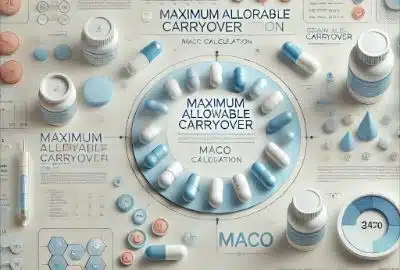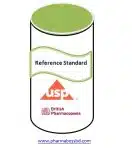MACO (Maximum Allowable Carryover) Calculation is a key function in cleaning validation to determine the acceptable level of residue of a previous product that can be carried over to the next product without risking patient safety.
The MACO calculation depends on factors like the therapeutic dose of the products involved, the type of cleaning performed, and the equipment surface area.

There are several ways to calculate MACO, but the most commonly used method is based on dose-based criteria.
1. Dose-Based MACO Calculation
The dose-based approach ensures that the residue carried over into the next product will not exceed a safe limit based on the doses of the previous and subsequent products. The formula is as follows:
MACO = Minimum therapeutic dose of the previous product ×Equipment surface area/Maximum daily dose of next product
Explanation of Terms:
Minimum therapeutic dose of the previous product: This is the lowest dose (in mg or µg) at which the previous product is therapeutically effective.
Equipment surface area: The total surface area (in cm²) of the equipment that comes in contact with the product.
Maximum daily dose of the next product: The highest dose (in mg or µg) of the next product that a patient would take in a day.
Example of Dose-Based MACO Calculation:
Suppose:
Minimum therapeutic dose of previous product (Product A): 10 mg
Maximum daily dose of next product (Product B): 2000 mg
Surface area of the equipment: 10,000 cm²
Calculation:
MACO=10mg×10,000cm²/2000mg
MACO=100,000mg⋅cm²/2000mg
MACO=50cm²
Thus, the maximum allowable residue of Product A that can be left on the equipment is 50 mg per surface area of the equipment.
2. Toxicological-Based MACO Calculation
In cases where the previous product is highly potent or toxic, a toxicological-based MACO is calculated to ensure patient safety. This involves using safety factors such as the Acceptable Daily Exposure (ADE) or Permitted Daily Exposure (PDE), as well as the Safety Factor (SF) and Body Weight (BW) of patients.
The formula is:
MACO=ADE×BW/SF
Explanation of Terms:
ADE (Acceptable Daily Exposure): The amount of substance that can be taken daily without any adverse effect.
BW (Body Weight): Average body weight of a patient (typically 50 kg or 70 kg for an adult).
SF (Safety Factor): A factor applied to account for uncertainties, typically in the range of 1 to 1000.
This approach is used especially when dealing with highly potent or toxic drugs such as certain hormones or cytotoxic agents.
Example of Toxicological-Based MACO Calculation:
Suppose:
ADE: 0.1 mg/day
Body weight: 70 kg
Safety factor: 100
Calculation:
MACO= 0.1mg/day×70kg/100
MACO=7mg/100
MACO=0.07mg/day
3. Swab Limit Calculation (for Sampling Purposes)
Once the MACO is calculated, you can derive the swab limit, which is the amount of residue allowed per swabbed surface area (usually in µg/cm²). This is useful for actual residue testing during cleaning validation.
Swab Limit= MACO/Equipment Surface Area
Example:
If the MACO for a product is 50 mg and the total equipment surface area is 10,000 cm²:
Swab Limit= 50mg/10,000cm²
=0.005mg/cm²=5μg/cm²
Thus, the acceptable residue limit for each swabbed area is 5 µg /cm².
Summary of MACO Calculation
Dose-Based Approach: Most commonly used in general cleaning validations.
Toxicological-Based Approach: Used when dealing with highly toxic or potent substances.
Swab Limit Calculation: Derived from the MACO for sampling purposes during validation.
In all cases, the goal is to ensure the safety of the next product by preventing unacceptable levels of contamination from the previous product.
Frequently Asked Questions (FAQs)
What is MACO (Maximum Allowable Carryover) Calculation?
MACO, or Maximum Allowable Carryover, is a calculation used primarily in pharmaceutical manufacturing to determine the acceptable level of residual product that can remain in equipment after cleaning. This ensures that any carryover from one product batch to another remains within safe, specified limits, preventing cross-contamination and safeguarding patient health.
Why is MACO Calculation important in pharmaceutical production?
MACO Calculation is crucial because it minimizes the risk of cross-contamination between different drug products manufactured on shared equipment. It provides a scientifically justified threshold for residue limits, which helps manufacturers meet regulatory requirements, maintain product integrity, and ensure patient safety.
How is MACO Calculation typically performed?
MACO Calculation involves several steps, including identifying the Active Pharmaceutical Ingredient (API) potency, the toxicity of the materials involved, the smallest therapeutic dose, and the batch size of the next product. Formulas may vary, but they generally consider these factors to establish a safe carryover limit, ensuring compliance with Good Manufacturing Practices (GMP).

Abdus Sobhan Salim is professional experienced pharmacist in pharmaceuticals, author and founder of pharmabossbd.com, the first Bangladeshi pharmaceutical blogger since 2019.



